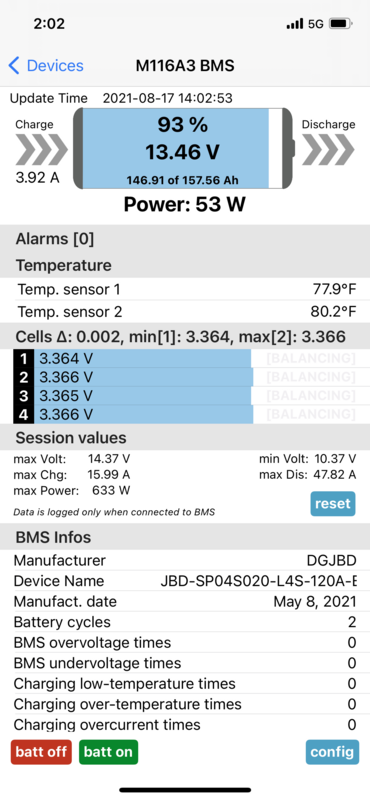Wow, It's been a while since I logged on! Here are some new developments about my M116A3 build.
Battery Update: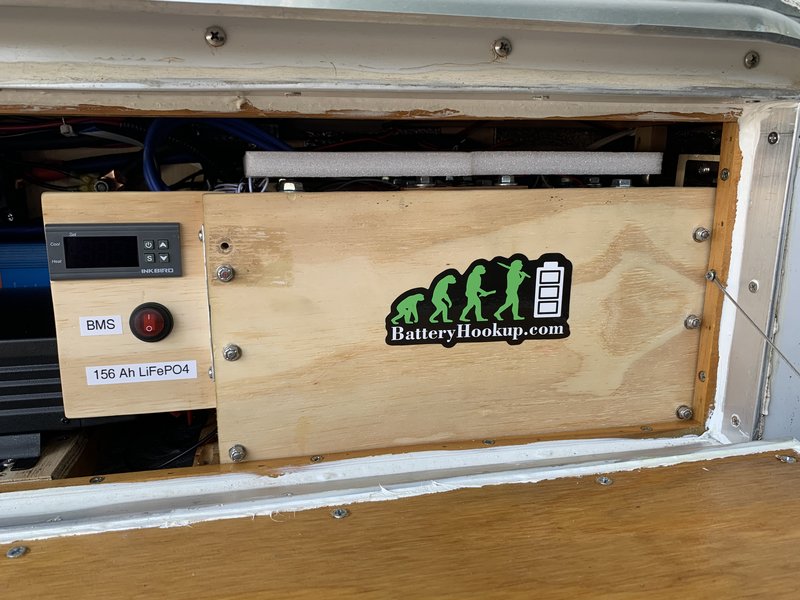
I would like to report that the 156 Ah LiFePO4 battery has been running like a champ for the last few months, in case anyone is reading this and thinking about building their own. I have done several long camping trips with the new battery, including one to the West Virginia mountains and one to Minnesota, and had no issues. We are starting to get freezing temperatures now in the Philadelphia region, but I haven't camped yet in a situation where the battery heater would be required. I can confirm that the Victron charge controllers will not push a charge to the battery if the temperature is below their set threshold (which I set to 38 degrees to be on the safe side). [I have the BMS set to not allow charging below 36 degrees as second safety net.] Since the trailer is just sitting idle outdoors right now, there is no need to run the battery heater, because the daytime temperatures allow charging after mid morning or so. But, I did try the battery heater out in the early morning, and it does work. The two beehive heaters draw about 2.4 amps when on, which would be below 39 degrees. If I were camping in the cold, they would allow the battery to warm up before the sun came up, maximizing charging. They'd also get some secondary help from the Propex heater in the trailer! When I do my first below freezing camping trip this winter, I'll report back on how well the battery heating system works.
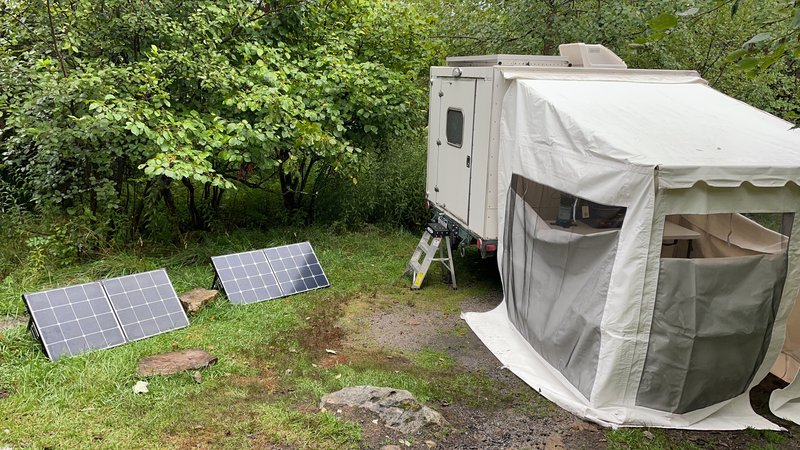
The key of course is to allow the solar panels to harvest more Ah from the sun than the battery heaters would burn keeping the battery warm.
Accessibility Mods:Up to recently, my wife and I have been using a step ladder to get in and out of the trailer, which did the job but was not ideal. For one, I had to put a dirty wet ladder inside the trailer when packing up in the rain. For another, it wasn't always stable depending on what ground we camped on. After having the ladder tip over and landing on my backside, I decided to get some real stairs. I would never want this to happen to my wife!
These stairs are by a company called EasyHitchStep, which is out of South Carolina. They are designed for pickup truck campers, and go into the receiver hitch on the truck.
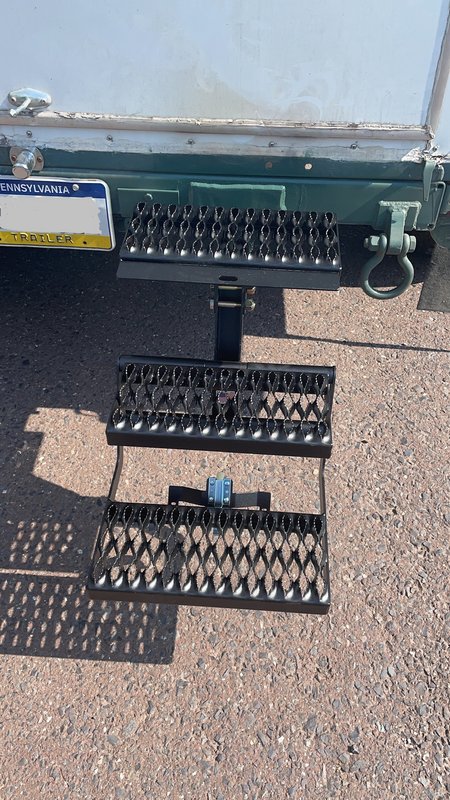
The beautiful thing about them is that they fold up and can remain on the back of the trailer while traveling from place to place. Of course, being in a receiver hitch, the stairs can be manually removed and stowed inside if I need extra ground clearance for driving off-road with my trailer.
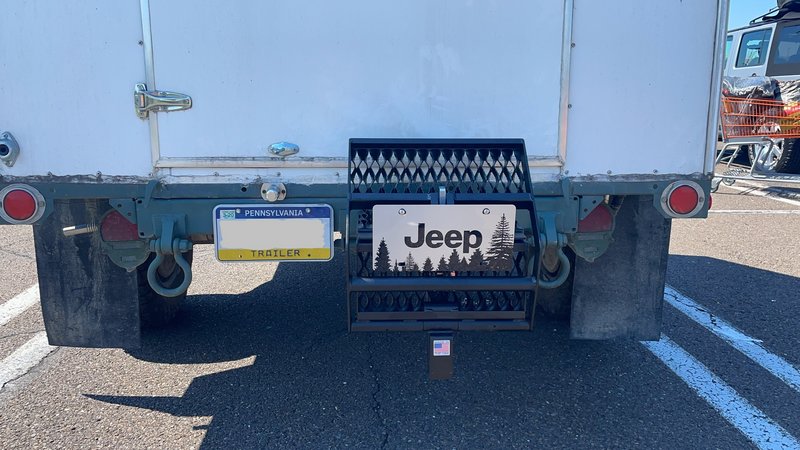
To be able to use these stairs, I had a local Jeep shop [Locked & Loaded 4x4] weld in and support a receiver hitch on the back of my trailer frame. If you're in the Philly metro area and need a great metal fabricator, send me a message and I'd be happy to refer you.

Finally, I installed a grab handle on the trailer to allow safer stair climbing!
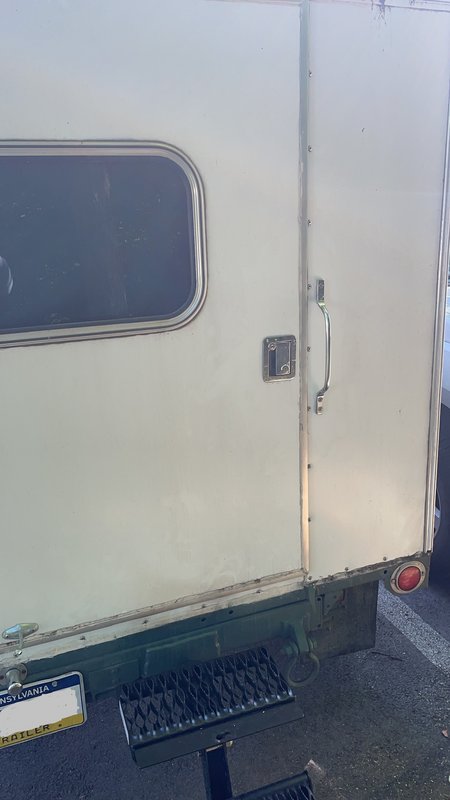 Kitchen Mods:
Kitchen Mods: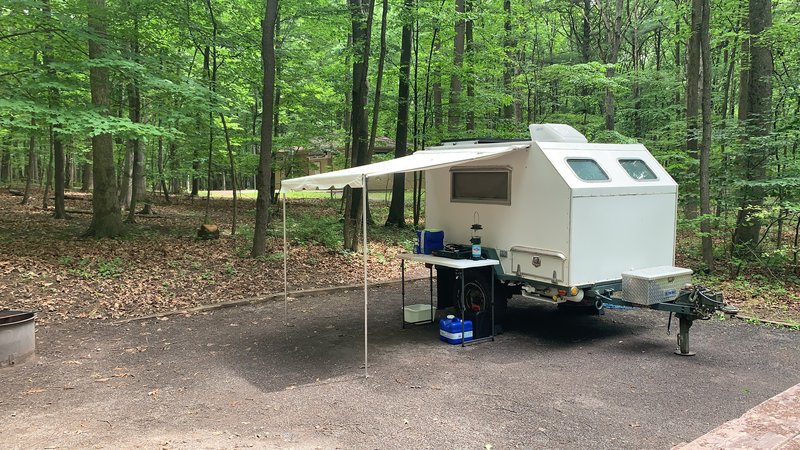
Our kitchen is on the passengers side of the trailer, under our Shademaker awning. In inclement weather, we can put sides on our awning room and run a Little Buddy heater to keep things warm in there. This fall, we decided to upgrade our stove. We had been running a Coleman 2 burner stove which we got almost 20 years ago as a wedding present. The stove served us well over the years, but it wasn't the fastest thing in the world. Now that we have a propane tank on the trailer itself, we have the potential to run a better stove. I was able to find this 20,000 BTU Camp Chef Everest stove online for cheap. It was new and never used, but dented. I did a little body work on it, and it is as good as new.
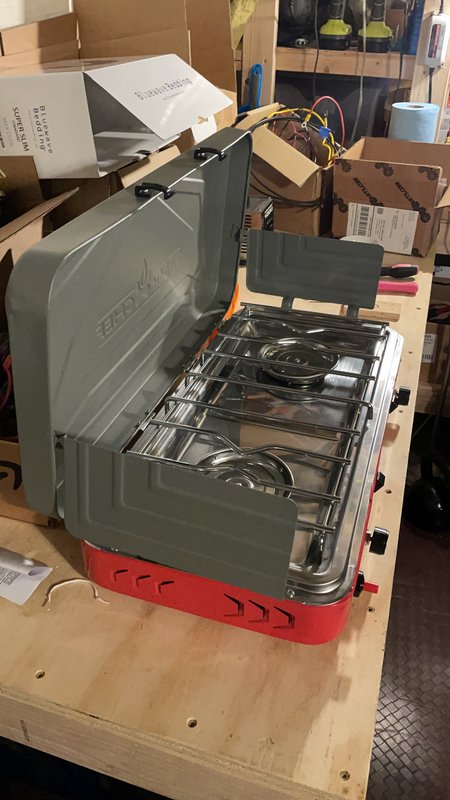
I bought a Buddy heater propane hose to connect it to the trailer's LPG tank. The Buddy brand propane hose does not have problems with oily residue developing inside, and so does not require an in-line filter. It keeps the stove burners running efficiently and clean.
Also on the kitchen side of the trailer I installed a waterproof Blue Sea 12 volt power outlet. We had always had a 110 AC outlet there, but it required us to run our inverter when not connected to shore power. The 12 volt will provide all sorts of flexibility in the kitchen.
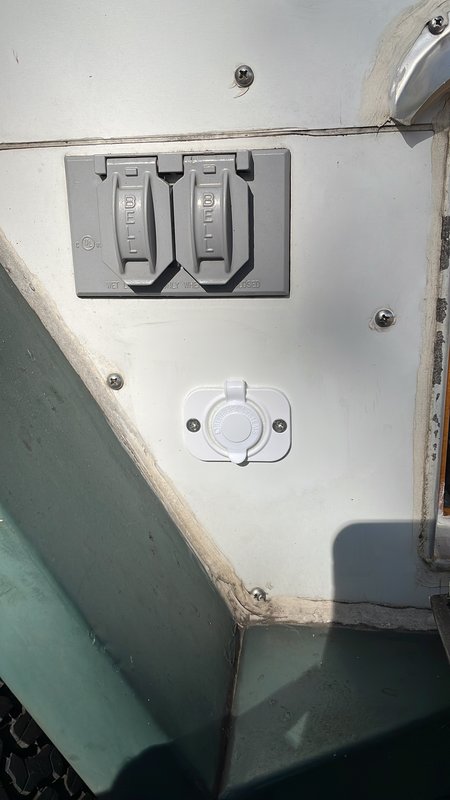
First, it powers an LED light strip. We never had a light on the kitchen side of the trailer (if building a camper from scratch again, I would add one), so we either used flashlights, phones, or our 20 year old Coleman lantern. Now, we have dimmable LED lighting! The light strip is by a company called TuffStuff, and has both adjustable velcro straps and clips. It connects easily under our awning, as it was designed to be used inside roof top tents.
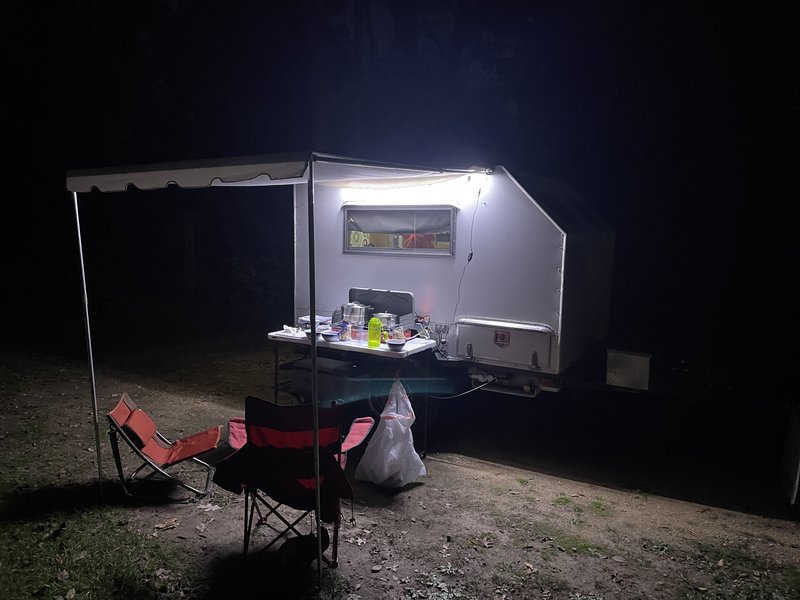
Second, using a 12 volt splitter, I can run other kitchen gadgets without unplugging the light. I can put our 12 volt fridge under the table in the kitchen instead of keeping it under the bed in the trailer. (Of course in bear country I would not leave it outdoors.) Keeping the fridge in the kitchen is so much more convenient for meal prep and morning coffee! Another important use I got out of the kitchen 12 volt socket was running a heated sleeping bag liner. I came down with a sinus infection on our last trip and snored like a buffalo. The solution to keeping my wife sane and letting her sleep was to move me to a cot and sleeping bag inside the kitchen tent. I was nice and toasty warm.
Future Mods:As you well know, a trailer project is never really "done"! My ideas for future fun mods center around the solar/battery system in the trailer. I have been super happy with my Victron 75/15 solar charge controllers and their BMV712 battery monitor. The Victron devices have allowed me to keep tabs on what is happening with the LiFePO4 battery, and made it easy for my wife and I to manage our power consumption on our camping trips. They run on a Bluetooth network and talk to each other, and there is a Victron smartphone app that makes it easy to check and set all the parameters. Of course I have to be "in range" of bluetooth to use the app. Sometimes that means standing right next to the trailer. Since my camper is not parked at home, I have to make periodic visits to it to keep tabs on battery status when we are not camping. Here is the solution!
I can monitor battery and charging using Victron's VRM system, from anywhere in the world. The Victron devices just have to be connected to the Internet! A way to do that is to connect them to Victron's Cerbo GX device, which is fairly expensive. A better way is to clone a GX device on a tiny microcomputer called a Raspberry Pi!
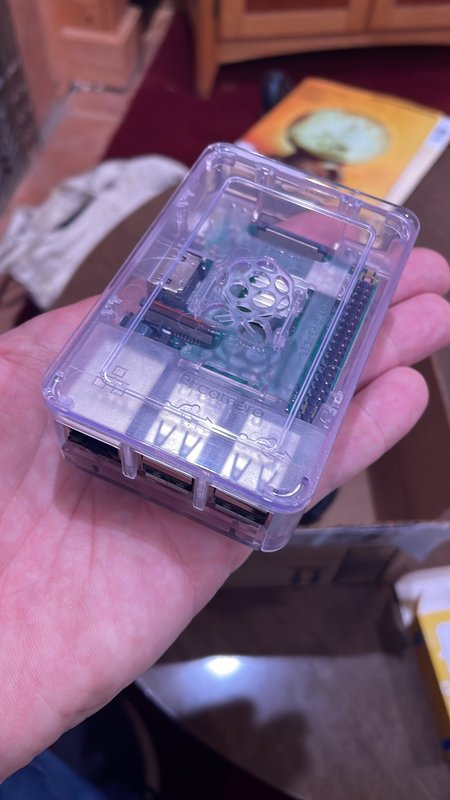
The Rpi is small enough to fit in my hand like a deck of cards! It also has a super low power draw.
The directions for setting up an RPi as a GX device and connecting the Victron controllers to it are elegantly described here:
https://off-grid-garage.com/victron-connect-through-raspberry-pi/I have learned so much from the Off Grid Garage's YouTube channel and highly recommend it. Fair warning, you will get hooked.
I am super excited to be able to keep tabs on my trailer's charging system from afar. The Raspberry Pi running the Victron GX software has to be connected to Wifi for this to work, however. The place I park my trailer doesn't have Wifi, so part 2 is getting 24/7 internet in the trailer. Raspberry Pi's can be programmed to run just about any project, which includes being a cellular modem. I ordered a cellular "hat" kit to go on a second RPi from
https://sixfab.com/ that essentially turns it into a hotspot device. The cool things about the Sixfab hotspot that make it better than a hotspot device from a regular carrier is that 1) they have a "SuperSim" card that can connect to more than one carrier, making it more likely you'll have connectivity wherever you go, and 2) there are places on the chip to connect cellular and GPS antennas, which increases usable range to cell towers. The Sixfab kit itself is not too expensive, but if you want to use it as a wifi hotspot to watch Netflix and not just for battery monitoring, high GB of service can get expensive quickly. Luckily the SuperSim card can be swapped out with sim cards from AT&T or T-Mobile, which offer high GB data plans at more affordable prices. I may eventually do that. In the short term, though, I can have my Victron GX RPi connect to my Sixfab hotspot RPi and access the internet for $9 a month (500 MB).
That's it for now! Happy to answer any questions about these things. I'll post up my process of programming the two Raspberry Pi's and installing them in my camper, in case anyone else is inspired to do that too. This will probably happen in the new year. Happy Thanksgiving, everyone!

 I'd be interested in your 3 year results if and when you run another capacity test.
I'd be interested in your 3 year results if and when you run another capacity test.


